See? I DID go outside!
And it was beautiful! The unseasonably hot weather broke last night and today was delightfully spring-like... and of course tomorrow night we're back down into possible heavy FROST. Ugh. That will do some damage to some of the plants I've been keeping an eye on to see what they turn into...
Anyway, I have pictures, but I am annoyed because several of them are lacking in identification despite my best efforts. Unfortunately, there are just too many very small spring ephemerals and they often live up to their name, being here and gone before people even see them. The trout lilies, for instance, were EVERYWHERE two weeks ago. Now they are all dead, their leaves curled up and turning brown, flowers long gone. The ants have already done their duty of carrying off the seeds and the flowers have finished their brief but busy lifespan in the few short weeks between the snow melt and the shadow of the tree canopy.
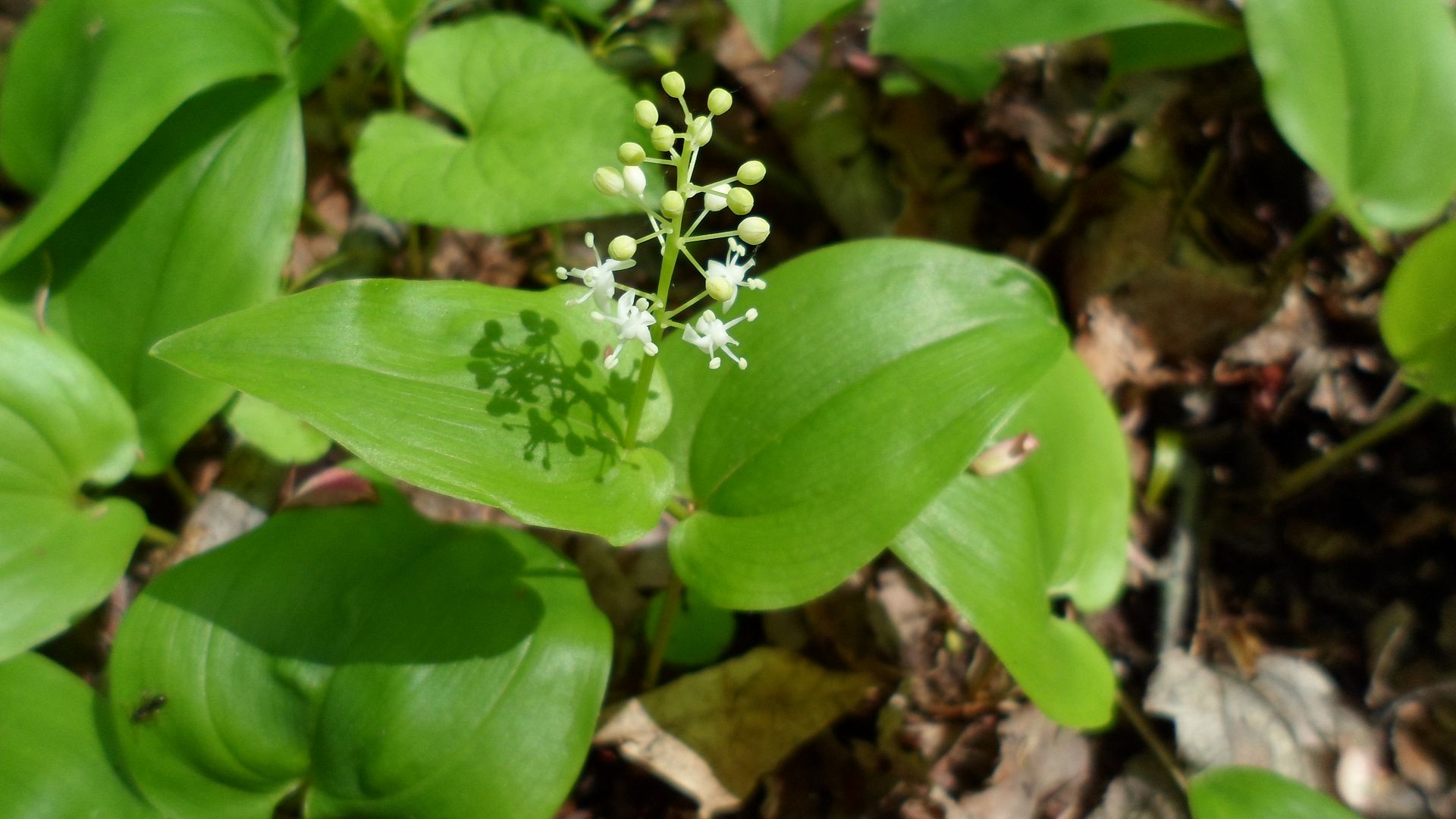
I think I may have an identification for these... they are everywhere and as they get bigger they have a fairly long stalk with a cluster of distinctive white flowers, and identification has eluded me in the past, but if it's what I think it is, it is False Solomon's Seal, or Maianthemum racemosum, an extremely common wildflower that lives everywhere in North America and prefers shady woodlands. I'm not completely sure about this, because the leaves are a bit different, but these are babies and the pictures are all of fully grown plants, and if I recall from previous years these leaves will get longer and more leaves will come up in the same arrangement (opposite on the stem) as it grows.
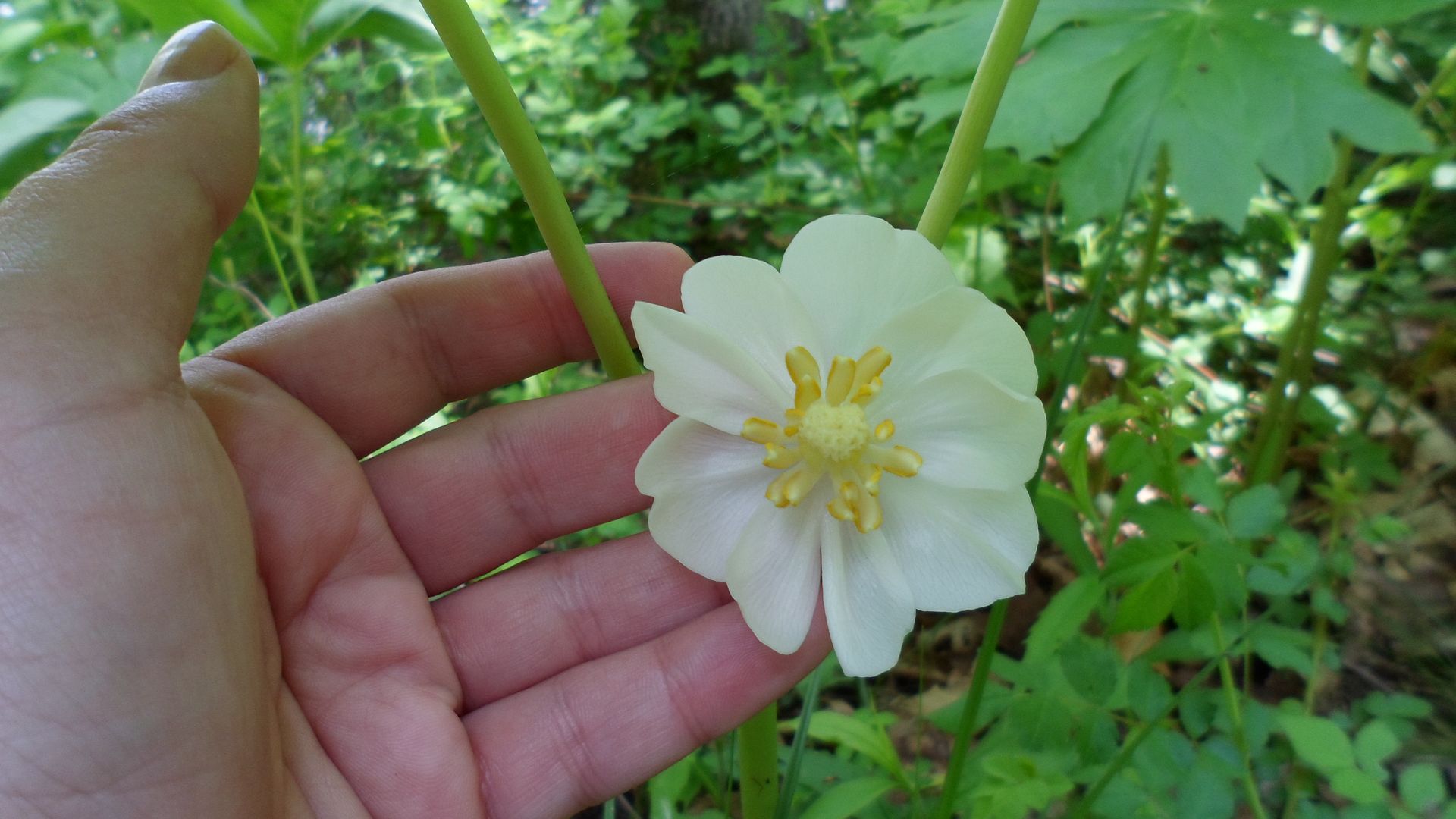
This beauty is never hard to identify because it is always hanging from the fork of the double umbrellas of a reproductive May apple. Only the double ones get flowers, or rather a flower, and will produce a single fruit. The flower don't have a very strong scent but they are lovely.
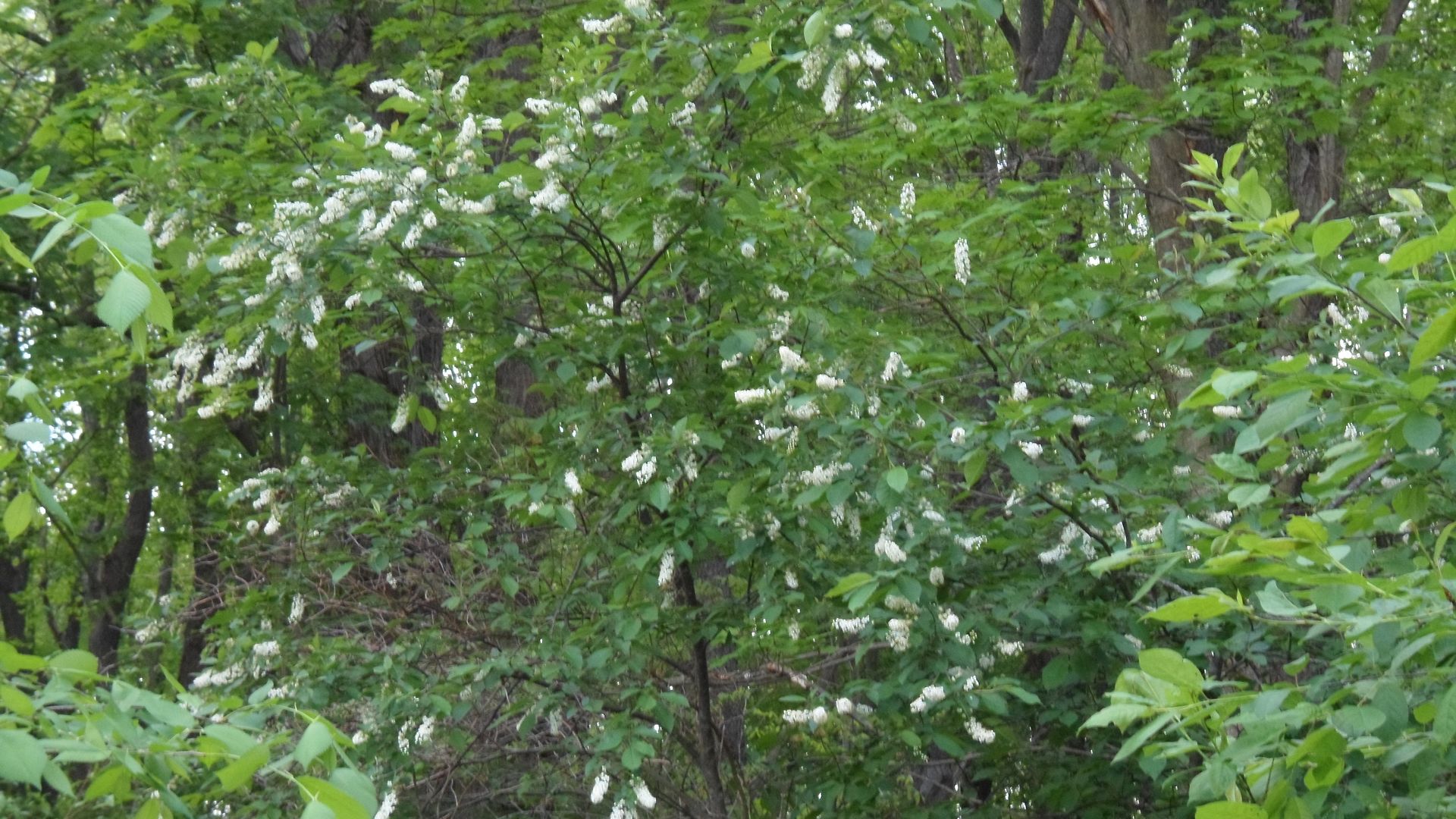
A bit of research because most of our trees around here that get white flower clusters get rounded ones, not elongated ones, and this one didn't look familiar (it was also growing in the middle of a bog which is why I don't have a close-up). I had thought I had it identified by the flowers as Virginia Willow or Virginia Sweetspire (Itea virginica). The only thing wrong with this identification is that Virginia Sweetspire is not a tree... it's a low-growing shrub that barely gets off the ground. Back to the drawing board...errr, field guide.
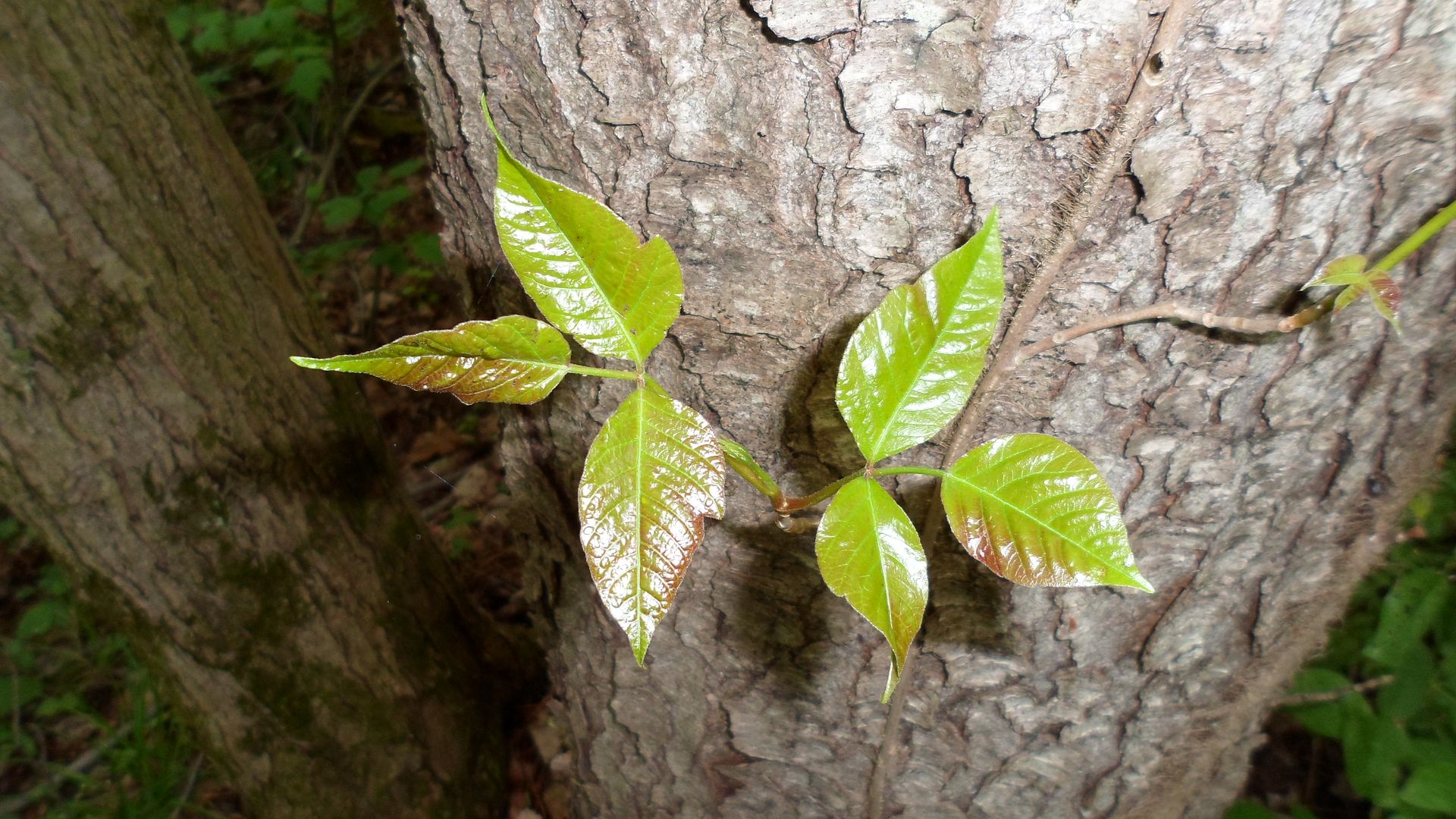
This was the poison ivy that sacrified a few nice, young, juicy leaves to my ongoing science experiment. I mashed them up into goo to make sure I released as much oil as possible and then rubbed it generously on my upper arm. Eight hours later, I am without so much as a red spot. And if I was going to become sensitized after repeated exposure, you'd think innoculating it under my skin and rubbing it all over me three or four times in three weeks would have done it. I'm fairly certain at this point that I am one of the 10+ percent of people who have no allergic reaction to poison ivy. SCIENCE!
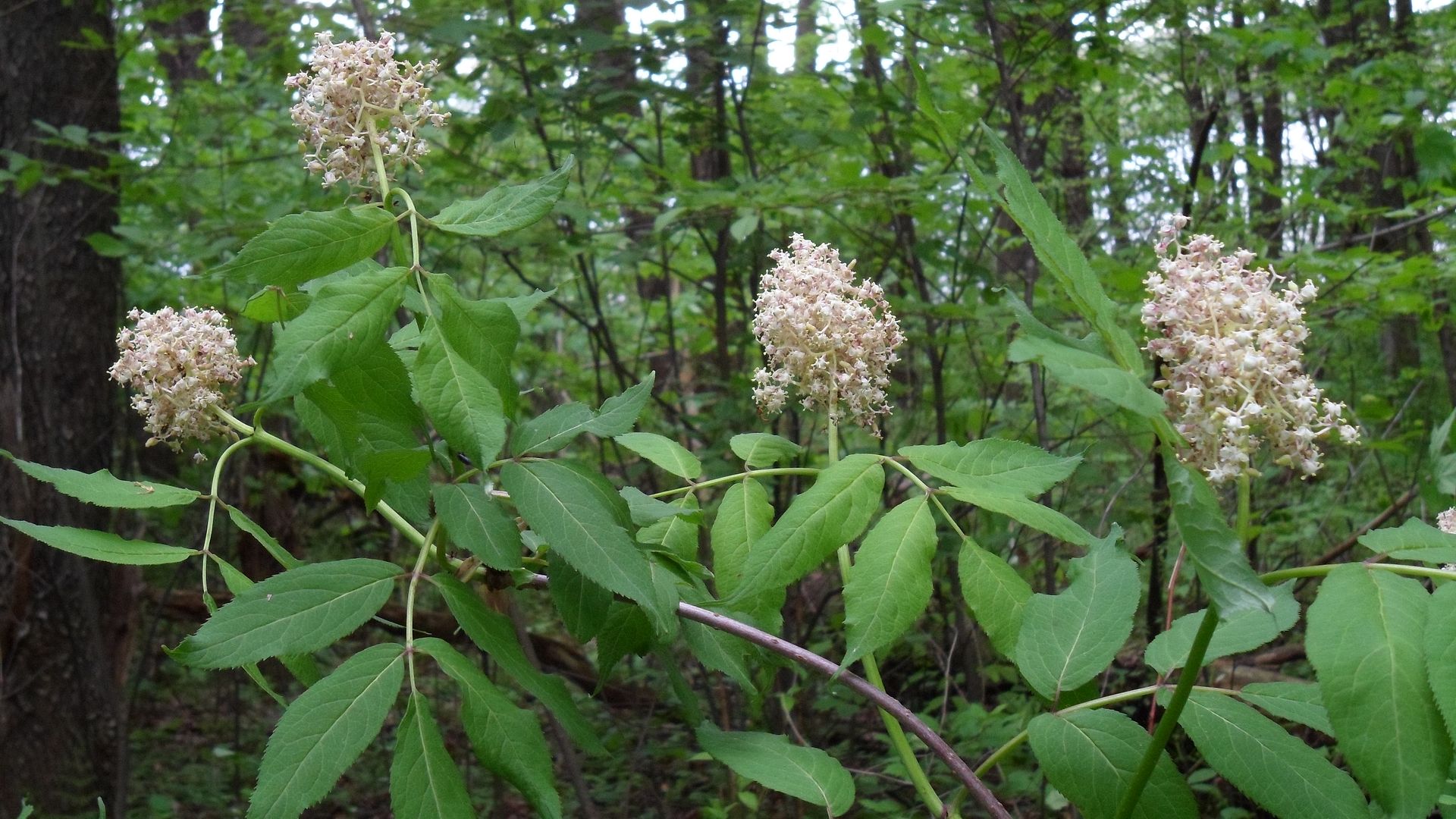
DAMNIT I SHOULD KNOW WHAT THIS IS. I am SURE I should know what this is. I've been going through the common shrubs in my head and it's not a dogwood (they don't flower in clusters like this) and it's not witch hazel (the leaves are all wrong) and it's not any kind of viburnum (the flower heads are too loose and messy) and it's not any kind of honeysuckle or rose. SO WHAT IS IT? This is the most infuriating identification failure from this walk because I AM SURE I SHOULD KNOW THIS ONE.
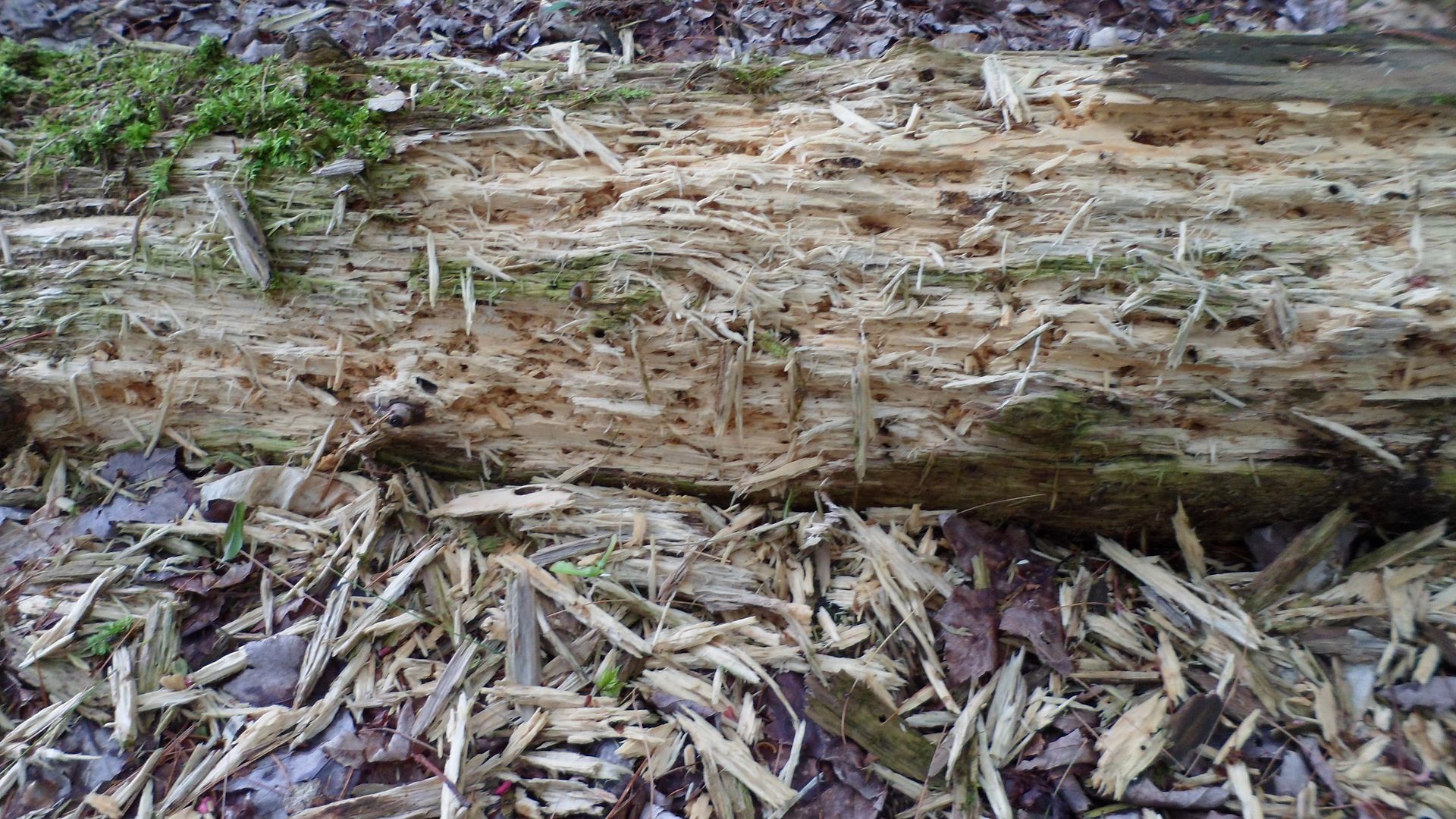
Woodpeckers didn't do this, although they got to this tree while it was still standing. I suspect a raccoon, because it appears that all those little holes were full of grubs, and it appears that something rather roughly ripped the wood apart to get to them. Little raccoon hands would be more than capable of this task, and would leave the bigger shreds instead of the chips woodpeckers leave.
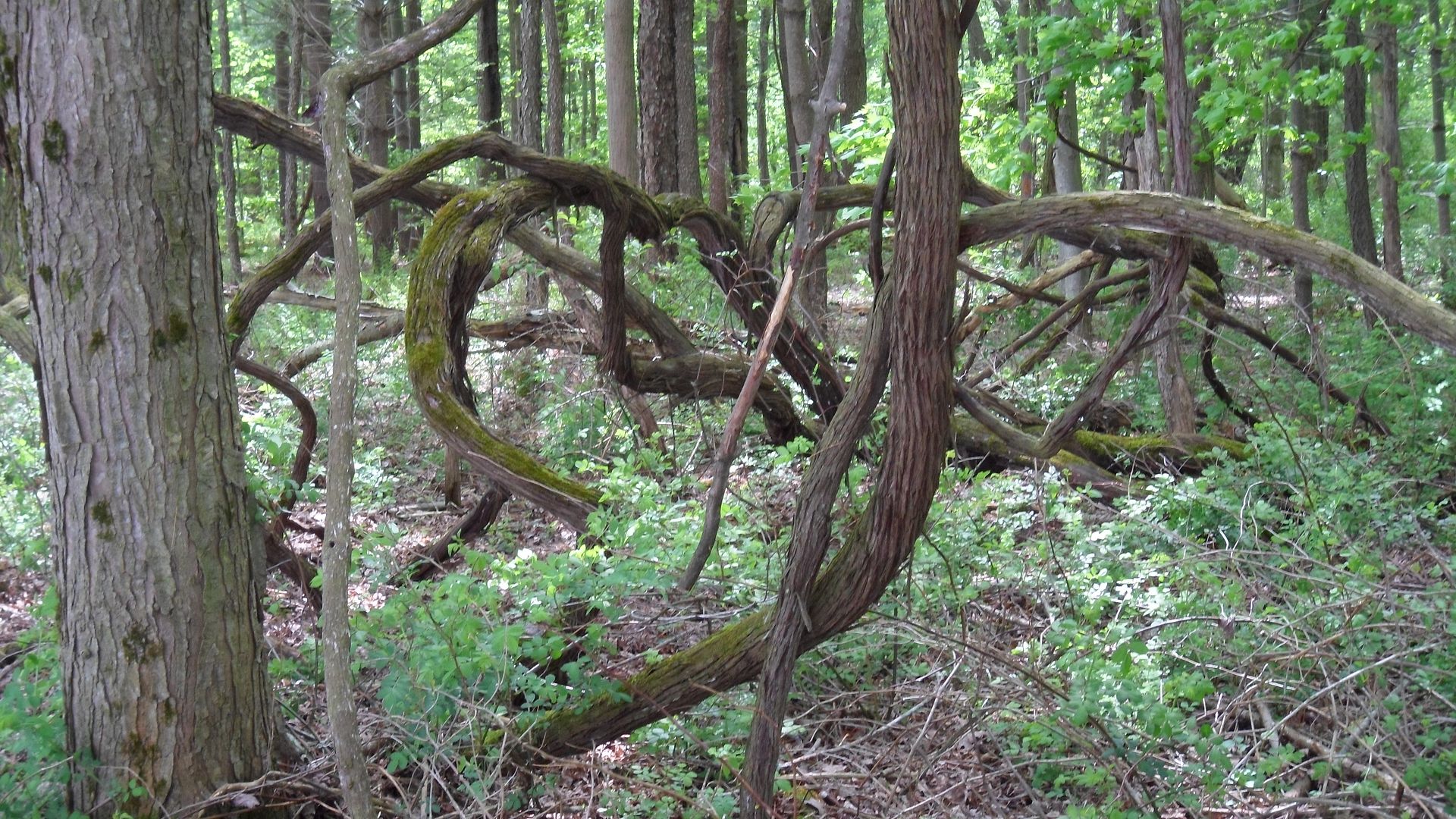
Species of wild grapes are native to most parts of the world. The one that's common here has a rather odd habit... it grows and grows, but as it does, it goes from small and twining to massive and woody and almost as thick as the trees it is climbing. Quite often, it ends up pulling down the entire tree. Then the tree rots away, but the grapevine, which is still alive, contines to grow in these convoluted knots all over the ground.
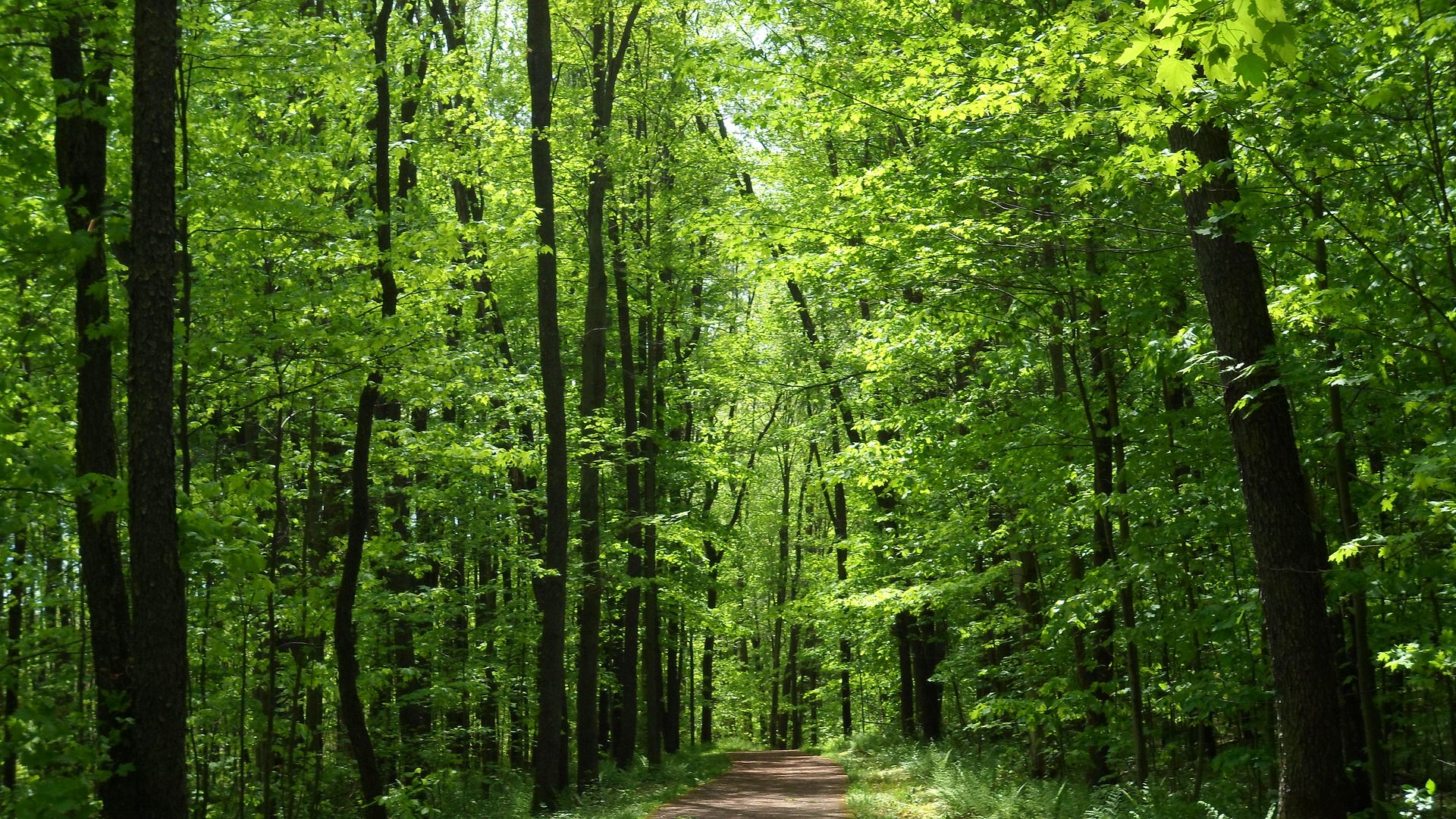
Spring happens abruptly here. Once the danger of frost is (usually) past, there is not a moment to waste.
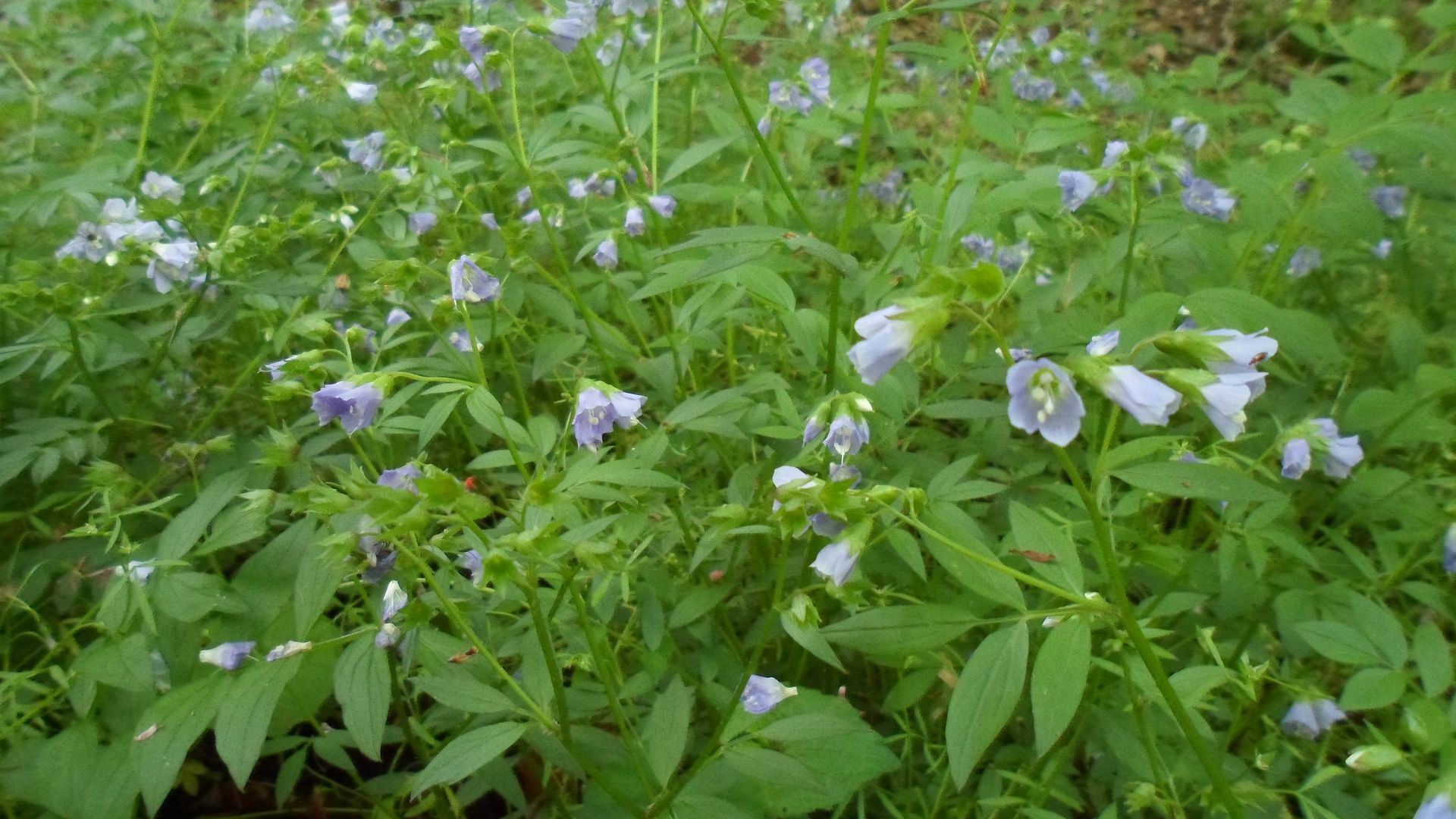
Another failed identification. My field guides say there is no light blue/purple flower that grows in small clusters and with leaves like that. Perhaps I must wait for them to mature, but something tells me they're probably an ephemeral and they'll be gone shortly.
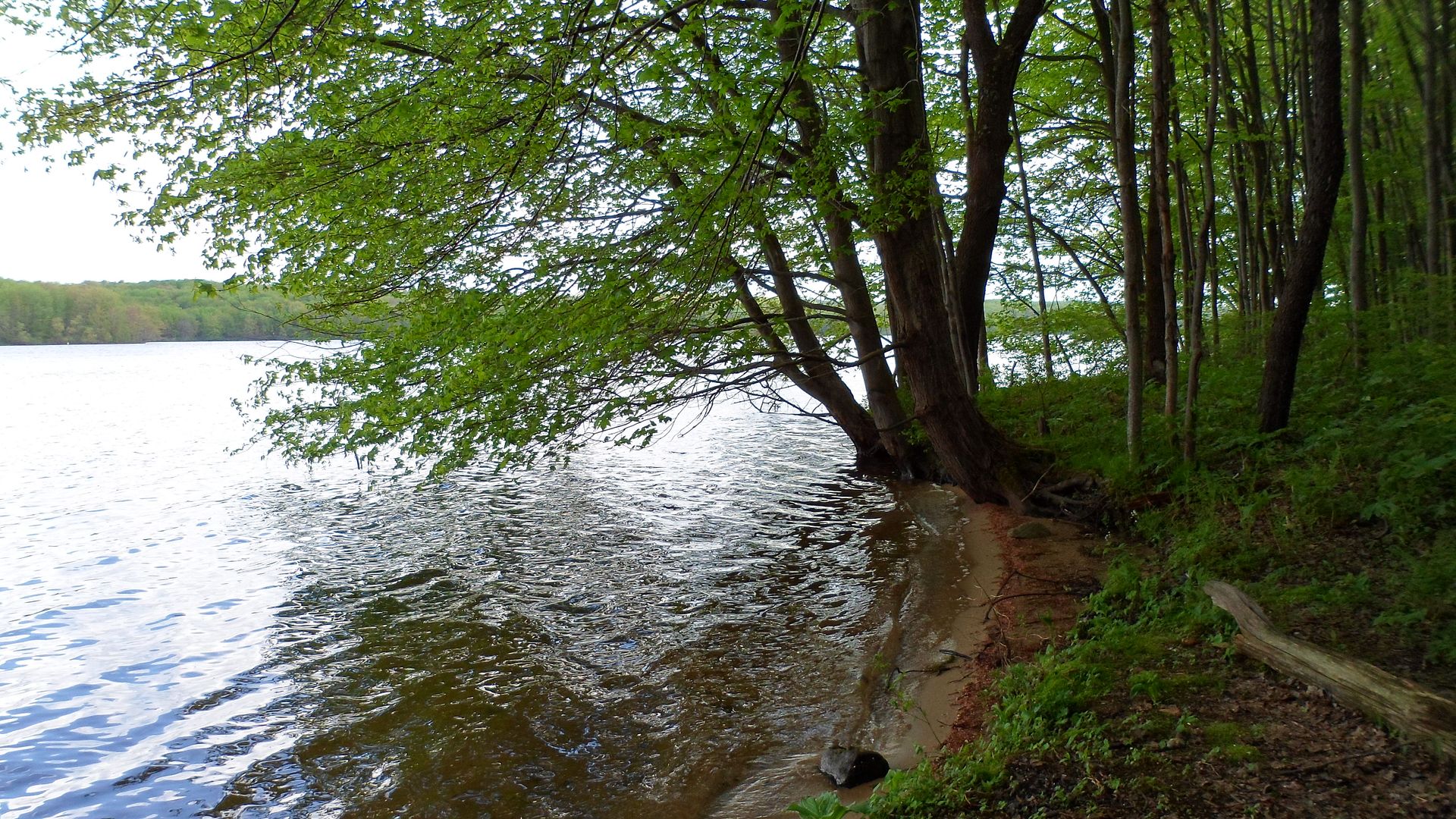
My lake, my lake... the water, the trees, the shore... my lake...
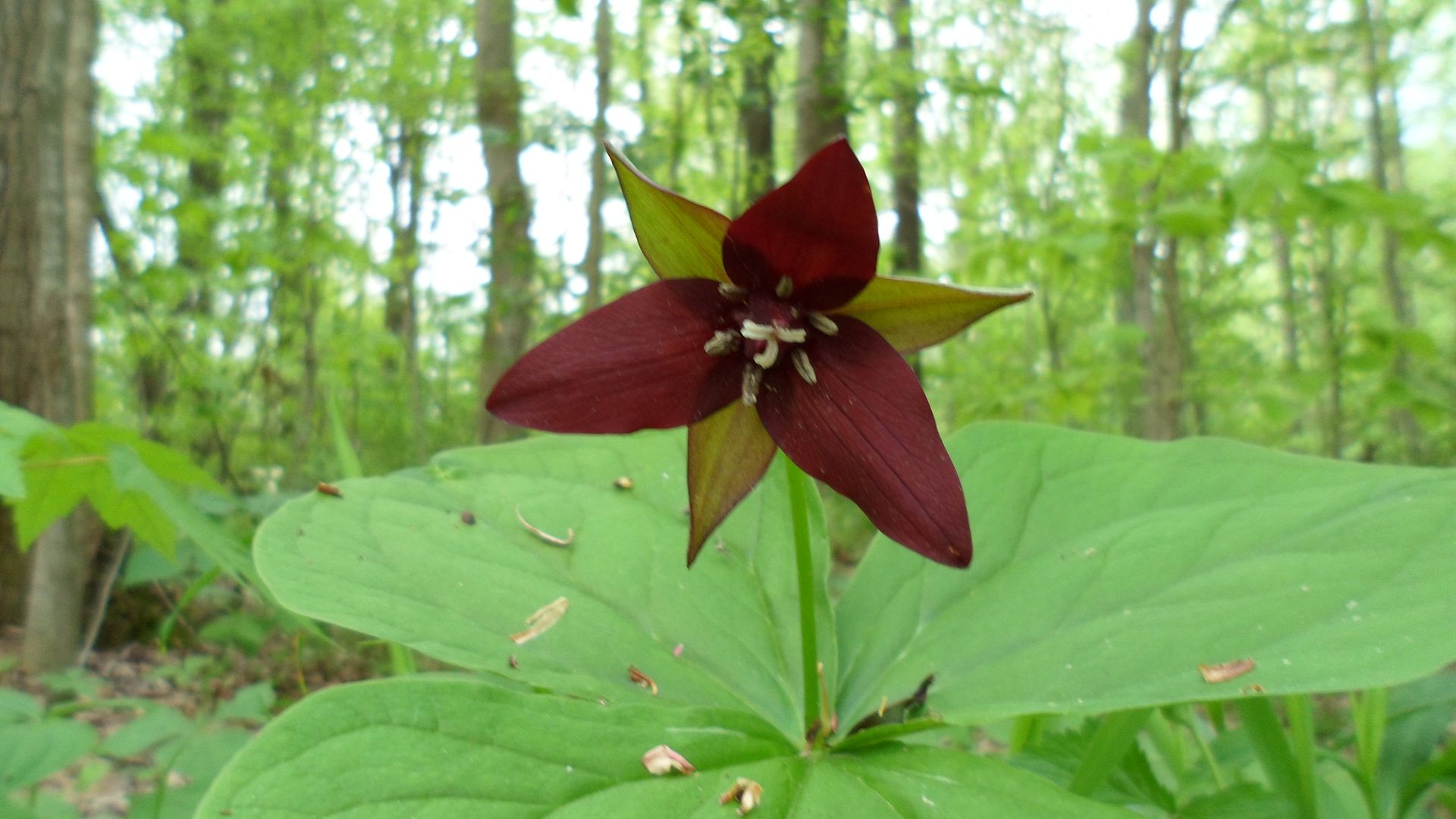
This is a nice close-up of the red trillium I've showed you before. I wouldn't necessarily bother showing it to you again, since you've seen both the red and the white color morphs...
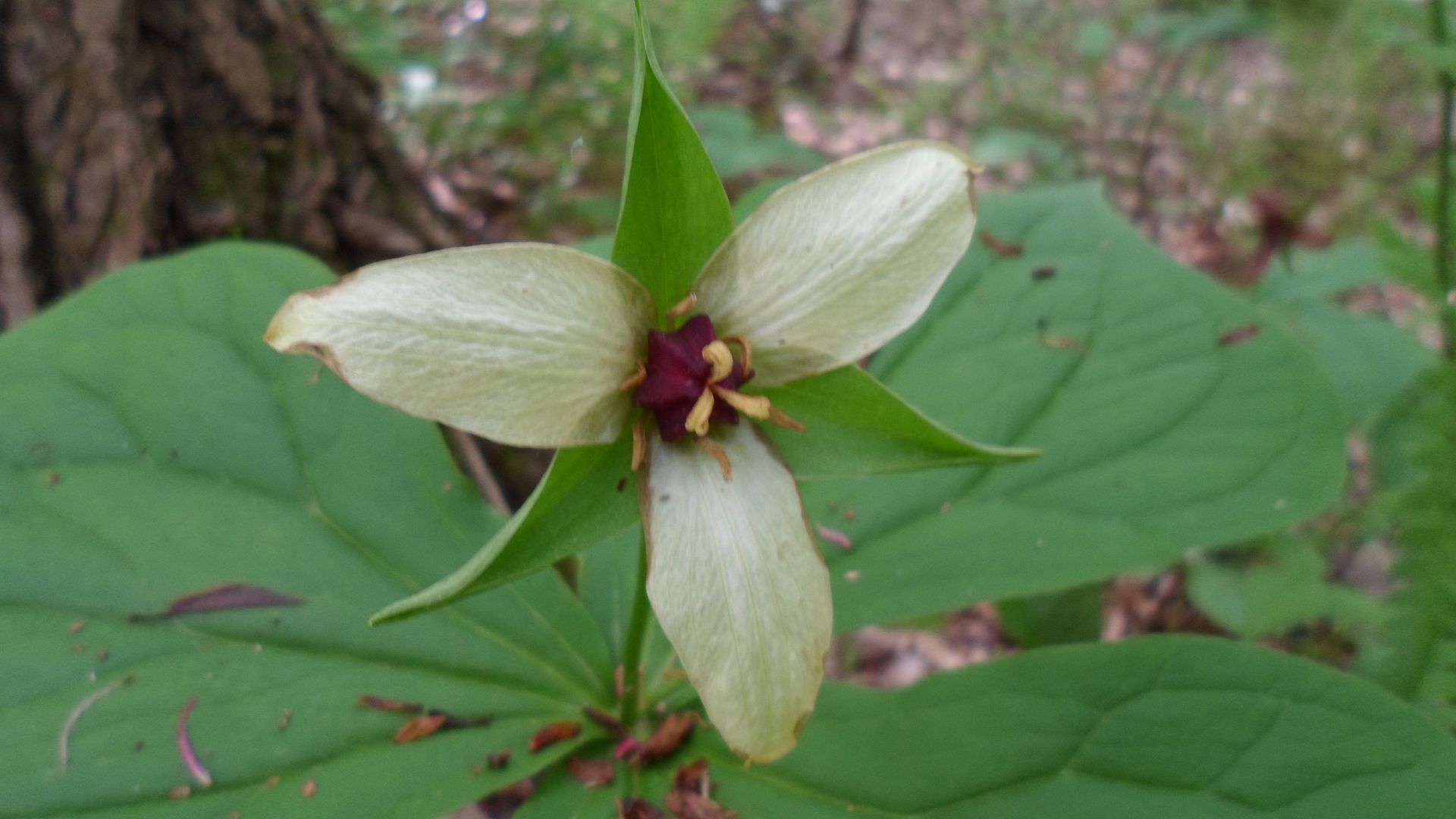
However, THIS is NOT the white color morph of the one above. This is a different species, although I'm still trying to pin down names for both of them. The top one is much more common, but I found several of these in a cluster near the water. The white morphs of the above type do not have the red cluster in the center, so this is another species. Still very pretty, and obviously the flower is, even though it's only mid-May, nearing the end of its lifespan, as all our local trilliums are early spring ephemerals and by June they are nowhere to be found.
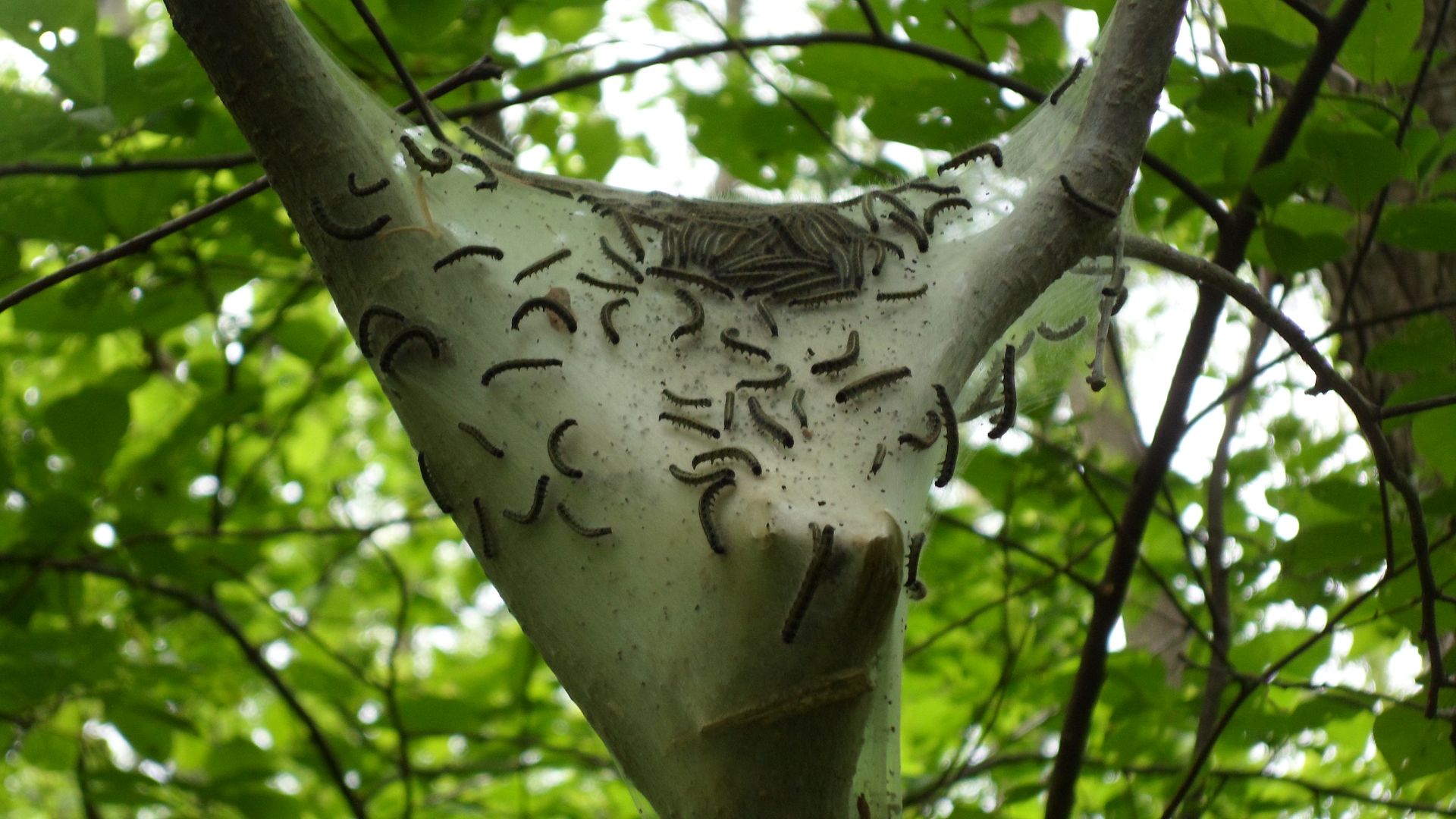
Just as proof that my love of nature, even of rot and decay and death and all the natural cycles of living organisms, only goes so far...
I FUCKING HATE TENT CATERPILLARS. HATE THEM. There's something about this that is wrong and horrible and I have no idea why, since other than the occasional defoliation of fruit trees they are completely harmless.
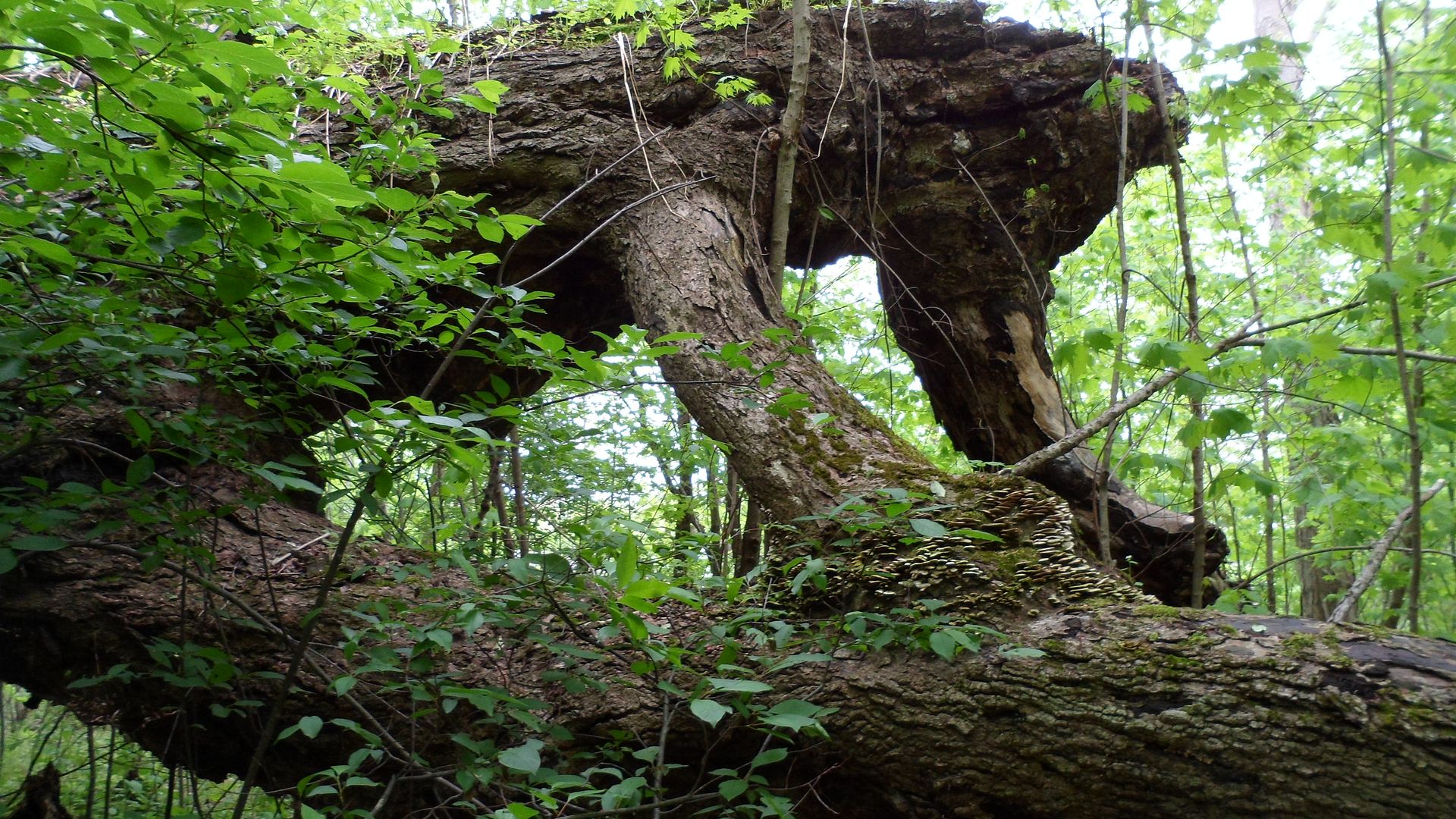
By June the briars will have made an impenetrable wall around this fallen giant, one of the largest trees I've ever seen around here. As it is, getting around it to take pictures is an exercise in pain and little stabby thorns attempting to remove one's clothing. Still, I wanted at least one... it looks almost more like a rock formation than a tree, and though there's no real perspective in this picture, the whole mass of the branching trunk lying on the ground is big enough for me to easily walk under.
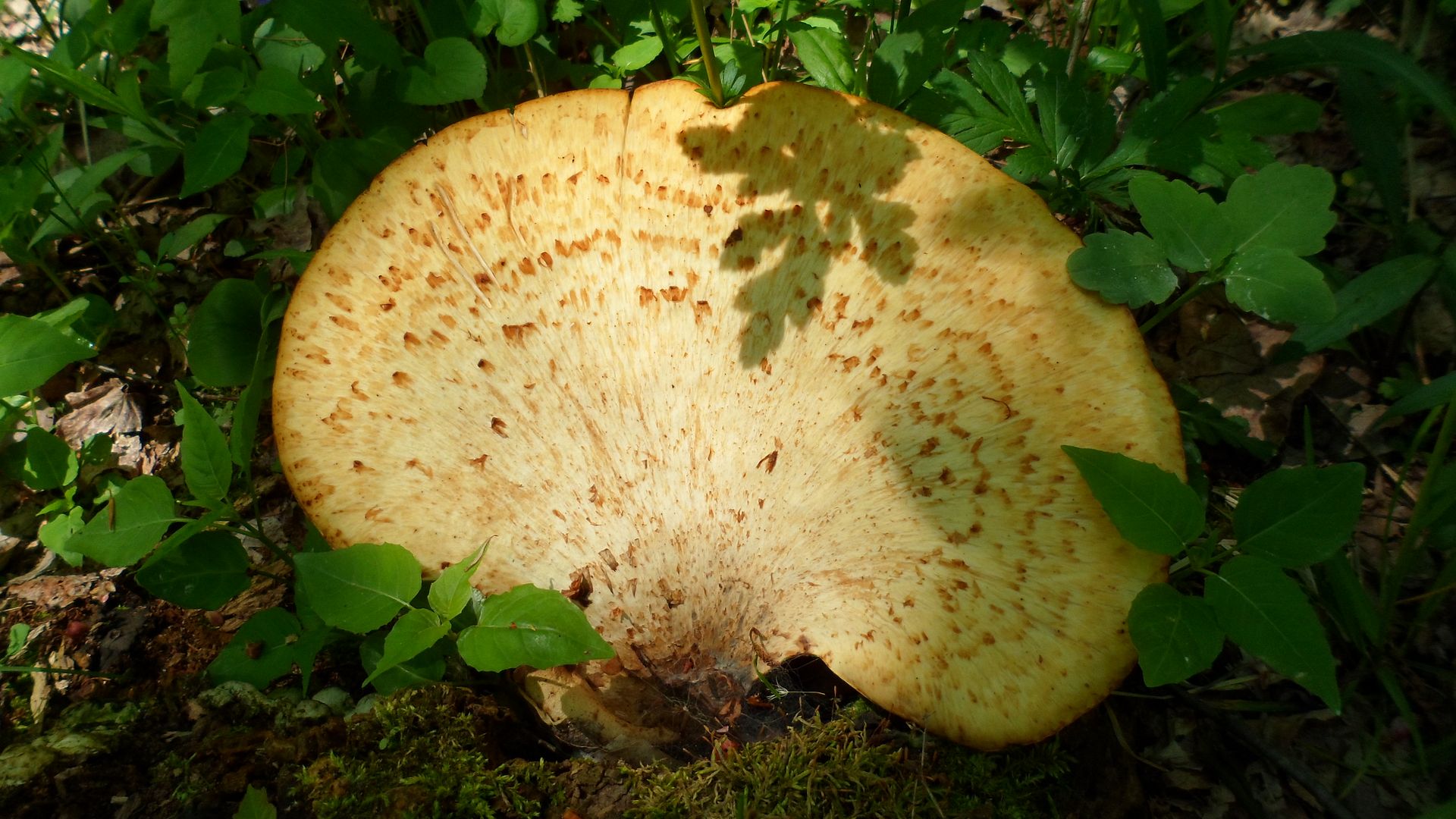
I've shown you dryad's saddle fungi, a wood decay fungus that particularly likes old rotty stumps, but this was such a pretty specimen and nothing had gotten there to eat it yet...
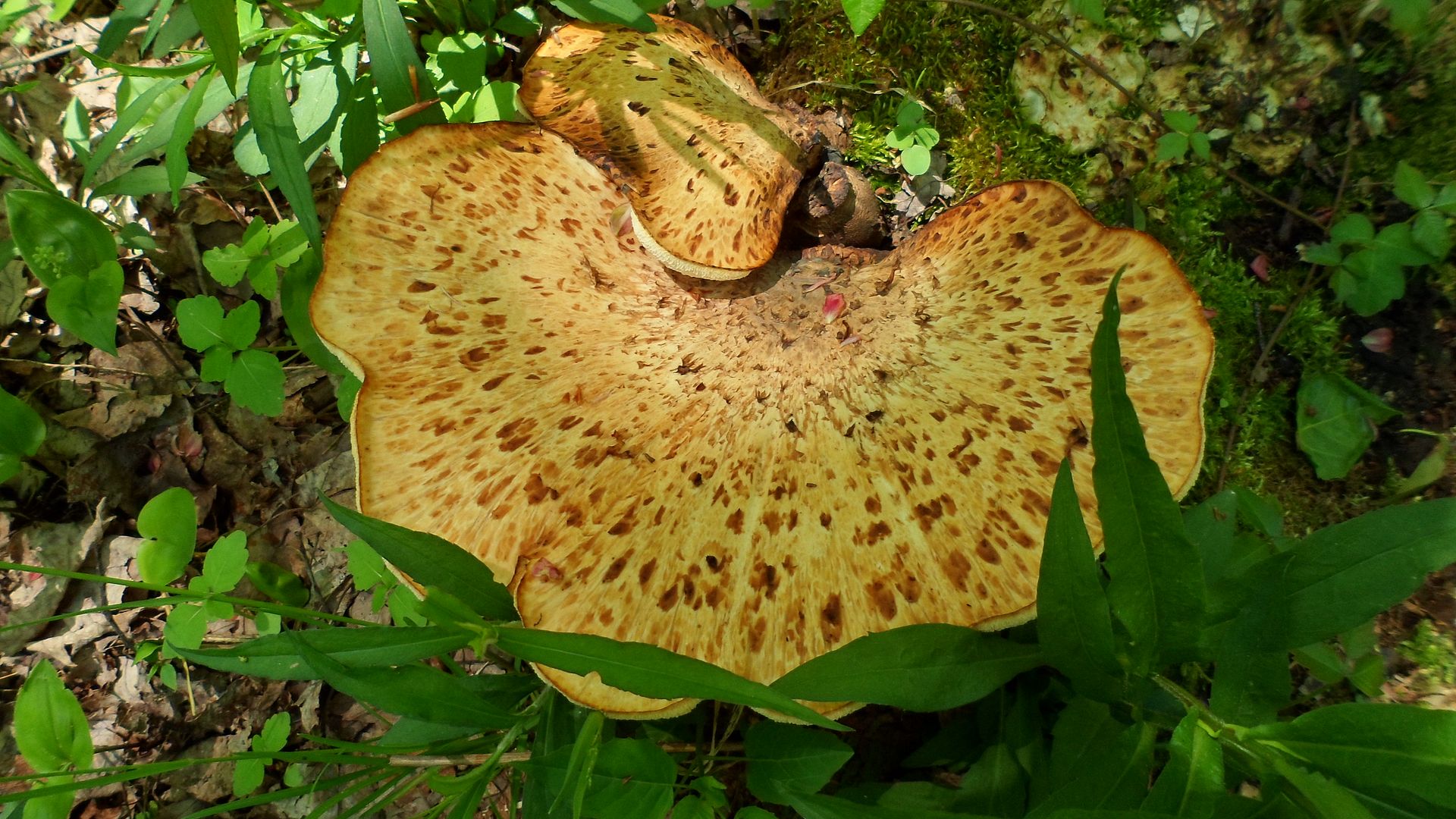
And these ones, of course, are equally pretty and equally fresh and untouched... after they have been out for a few weeks, they are usually full of maggots and start to have a bit of an odor.
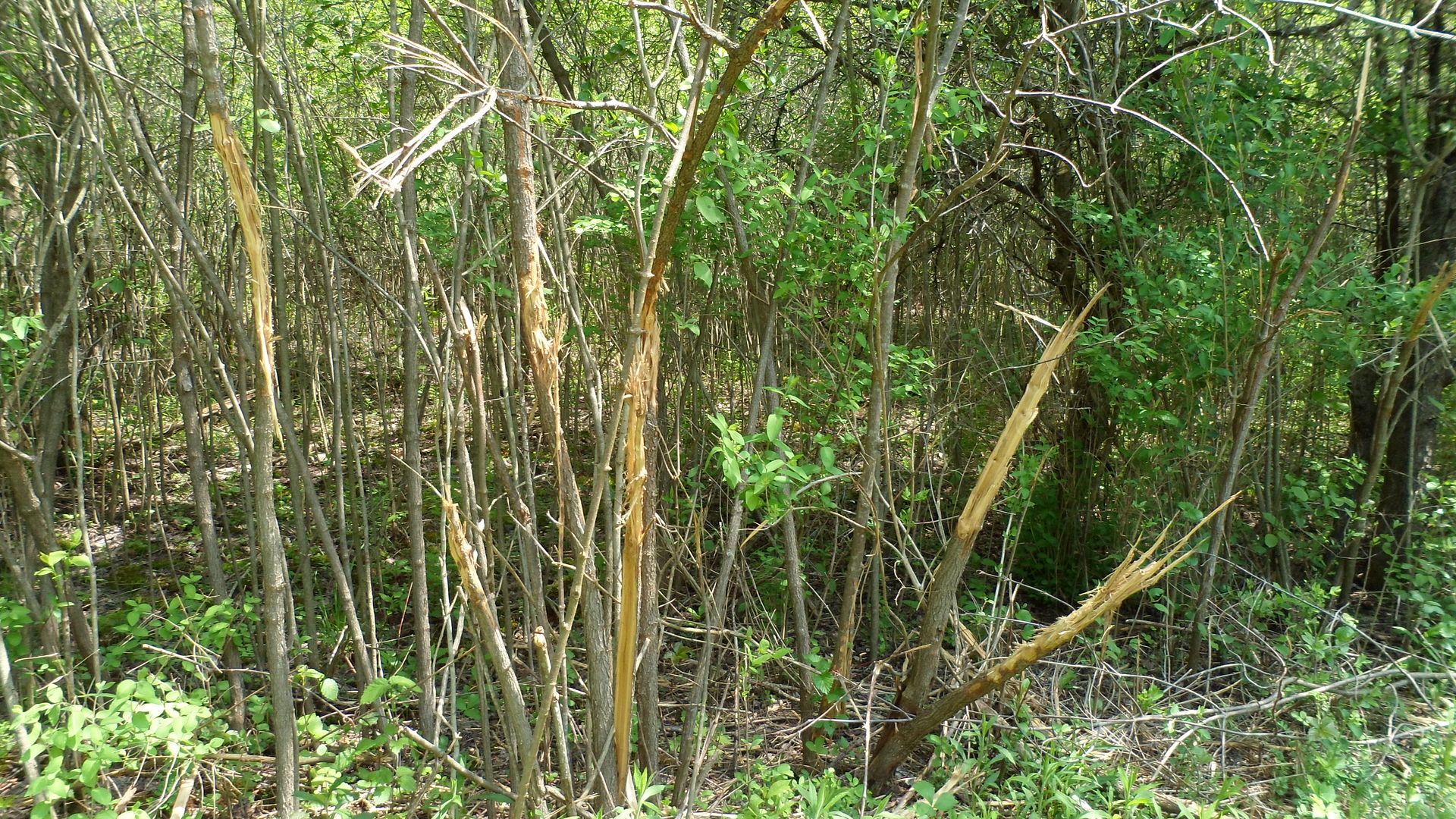
A porcupine has been at work here. This is why foresters are not fond of them.
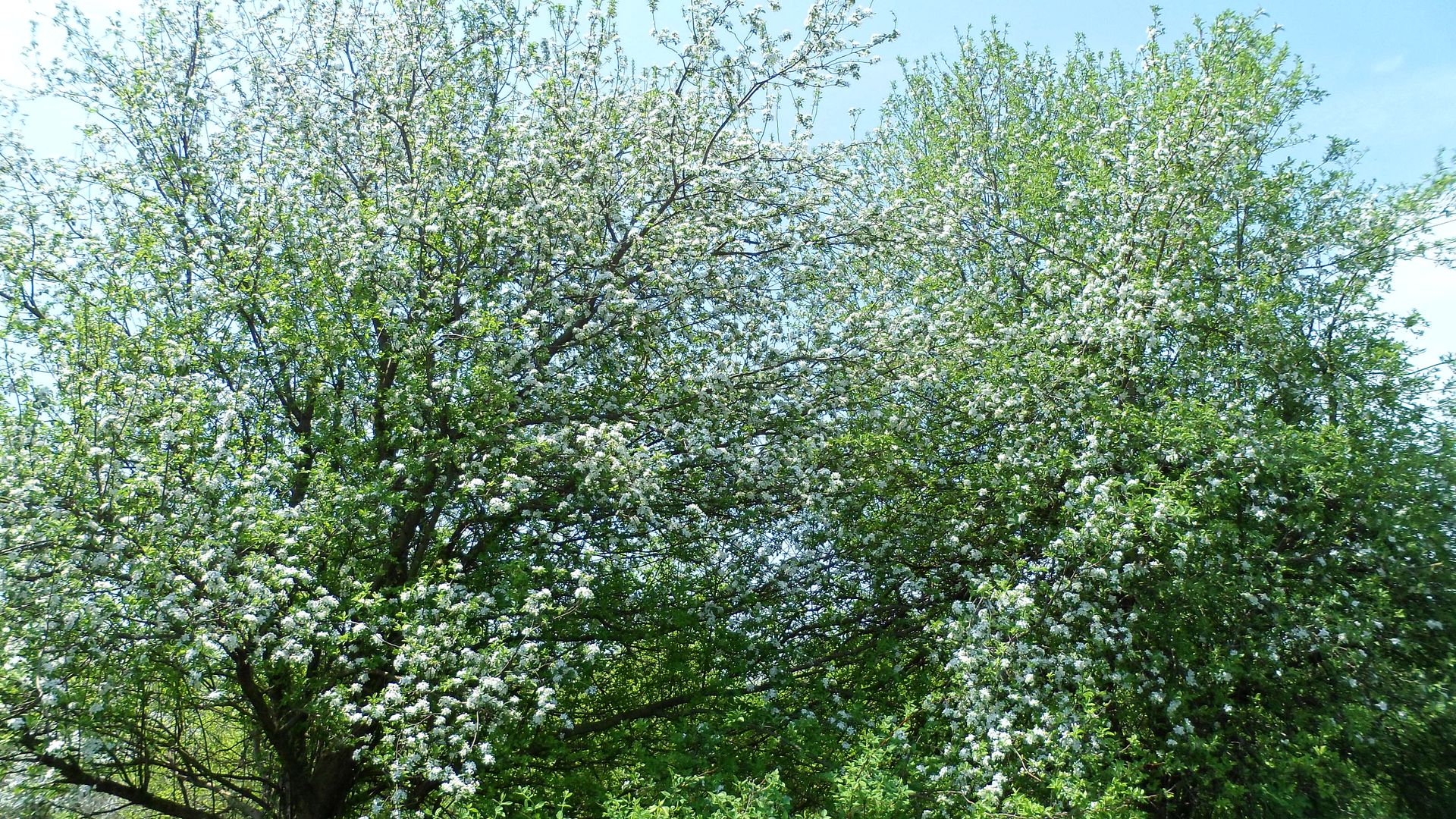
Crab apples aren't the most elegant fruit, but their trees may be among the most beautiful displays of springtime, and those lumpy fruits will provide food for many animals (and result in the uncoordinated meanderings of many drunk wasps who consume fermenting apples).
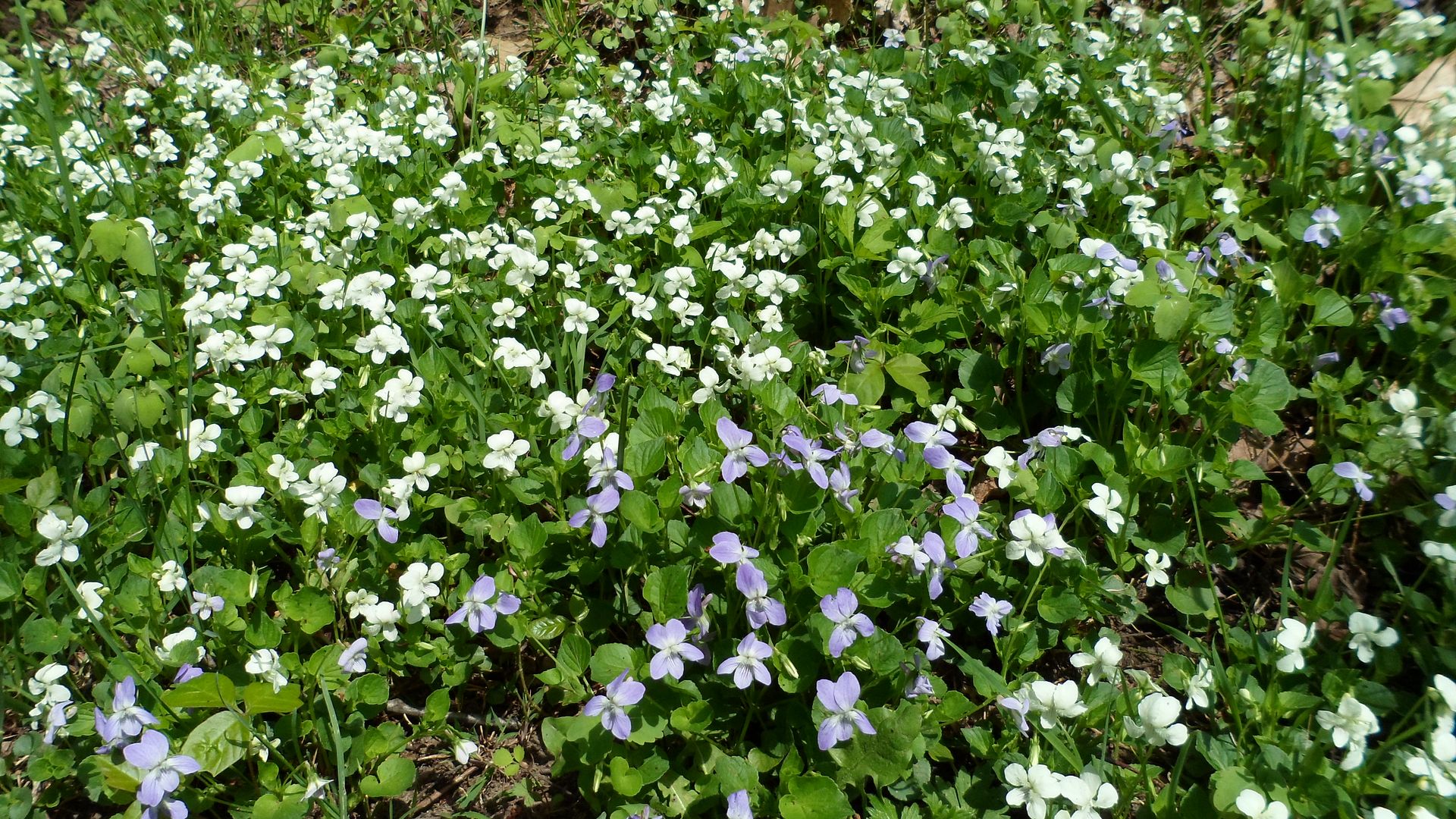
Apparently violets are not fussy about color, but this year, nearly all of them see to be white. I am not sure if they are color morphs of the same species or just close relatives, but they seem to live together very contentedly.
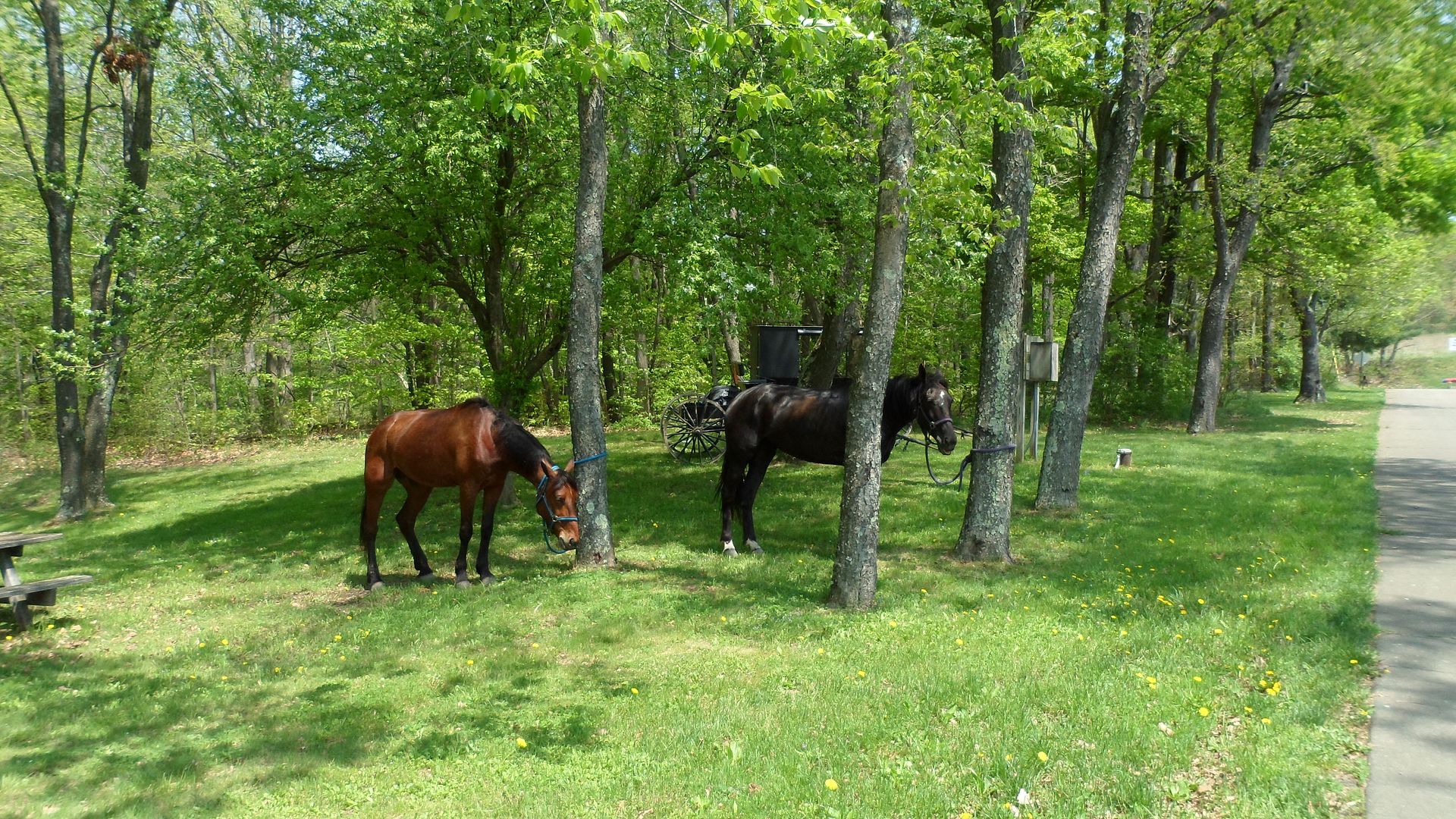
Amish horses enjoying an afternoon of lazing in the shade while their owners fish. Actually, as far as I know, the horses are not Amish.
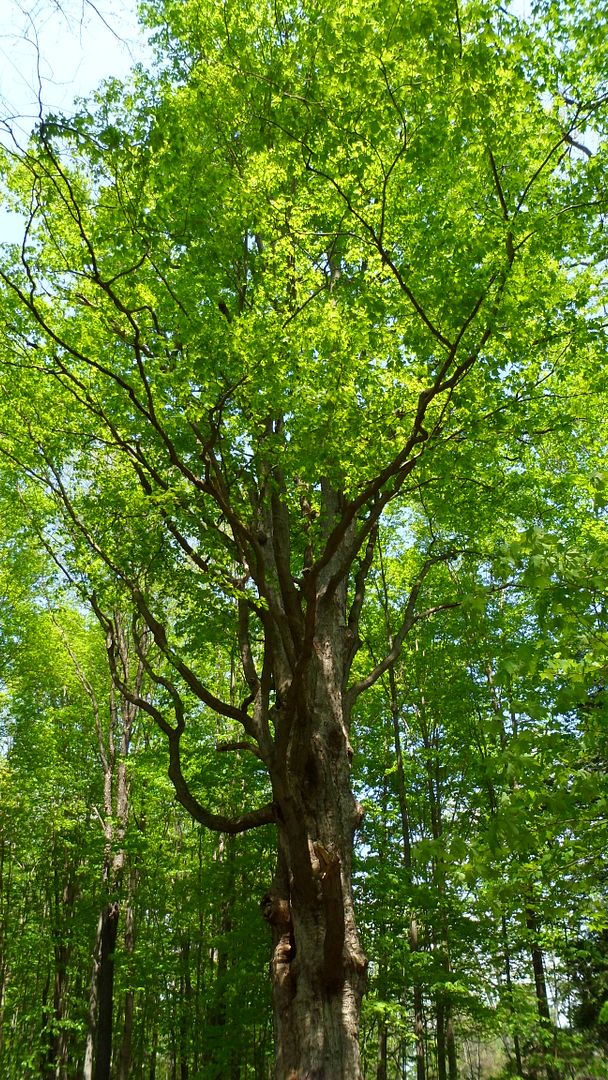
I've shown you many pictures of my ent, my giant ancient maple, but this time I got there at just the right time to have a view unobstructed by saplings and such...
This is my beautiful tree in its full glory, its canopy dominating its section of the forest, its old and knotted and pitted trunk standing tall. I'm not sure how people stroll past it and never even look up. Even if I'm jogging and trying to get a good time, I cannot go by without taking just a moment to lower my head against this tree and breathe the age and the life and the strength and the time that it is filled with. I hope it stands to see my grandchildren and I hope (probably in vain) that Brat will take them to sit at its roots and look up and wonder if a few of grandmother's molecules have come to rest in this great creature she felt so connected to.
.
.
.
Anyway, I have pictures, but I am annoyed because several of them are lacking in identification despite my best efforts. Unfortunately, there are just too many very small spring ephemerals and they often live up to their name, being here and gone before people even see them. The trout lilies, for instance, were EVERYWHERE two weeks ago. Now they are all dead, their leaves curled up and turning brown, flowers long gone. The ants have already done their duty of carrying off the seeds and the flowers have finished their brief but busy lifespan in the few short weeks between the snow melt and the shadow of the tree canopy.

I think I may have an identification for these... they are everywhere and as they get bigger they have a fairly long stalk with a cluster of distinctive white flowers, and identification has eluded me in the past, but if it's what I think it is, it is False Solomon's Seal, or Maianthemum racemosum, an extremely common wildflower that lives everywhere in North America and prefers shady woodlands. I'm not completely sure about this, because the leaves are a bit different, but these are babies and the pictures are all of fully grown plants, and if I recall from previous years these leaves will get longer and more leaves will come up in the same arrangement (opposite on the stem) as it grows.

This beauty is never hard to identify because it is always hanging from the fork of the double umbrellas of a reproductive May apple. Only the double ones get flowers, or rather a flower, and will produce a single fruit. The flower don't have a very strong scent but they are lovely.

A bit of research because most of our trees around here that get white flower clusters get rounded ones, not elongated ones, and this one didn't look familiar (it was also growing in the middle of a bog which is why I don't have a close-up). I had thought I had it identified by the flowers as Virginia Willow or Virginia Sweetspire (Itea virginica). The only thing wrong with this identification is that Virginia Sweetspire is not a tree... it's a low-growing shrub that barely gets off the ground. Back to the drawing board...errr, field guide.

This was the poison ivy that sacrified a few nice, young, juicy leaves to my ongoing science experiment. I mashed them up into goo to make sure I released as much oil as possible and then rubbed it generously on my upper arm. Eight hours later, I am without so much as a red spot. And if I was going to become sensitized after repeated exposure, you'd think innoculating it under my skin and rubbing it all over me three or four times in three weeks would have done it. I'm fairly certain at this point that I am one of the 10+ percent of people who have no allergic reaction to poison ivy. SCIENCE!

DAMNIT I SHOULD KNOW WHAT THIS IS. I am SURE I should know what this is. I've been going through the common shrubs in my head and it's not a dogwood (they don't flower in clusters like this) and it's not witch hazel (the leaves are all wrong) and it's not any kind of viburnum (the flower heads are too loose and messy) and it's not any kind of honeysuckle or rose. SO WHAT IS IT? This is the most infuriating identification failure from this walk because I AM SURE I SHOULD KNOW THIS ONE.

Woodpeckers didn't do this, although they got to this tree while it was still standing. I suspect a raccoon, because it appears that all those little holes were full of grubs, and it appears that something rather roughly ripped the wood apart to get to them. Little raccoon hands would be more than capable of this task, and would leave the bigger shreds instead of the chips woodpeckers leave.

Species of wild grapes are native to most parts of the world. The one that's common here has a rather odd habit... it grows and grows, but as it does, it goes from small and twining to massive and woody and almost as thick as the trees it is climbing. Quite often, it ends up pulling down the entire tree. Then the tree rots away, but the grapevine, which is still alive, contines to grow in these convoluted knots all over the ground.

Spring happens abruptly here. Once the danger of frost is (usually) past, there is not a moment to waste.

Another failed identification. My field guides say there is no light blue/purple flower that grows in small clusters and with leaves like that. Perhaps I must wait for them to mature, but something tells me they're probably an ephemeral and they'll be gone shortly.

My lake, my lake... the water, the trees, the shore... my lake...

This is a nice close-up of the red trillium I've showed you before. I wouldn't necessarily bother showing it to you again, since you've seen both the red and the white color morphs...

However, THIS is NOT the white color morph of the one above. This is a different species, although I'm still trying to pin down names for both of them. The top one is much more common, but I found several of these in a cluster near the water. The white morphs of the above type do not have the red cluster in the center, so this is another species. Still very pretty, and obviously the flower is, even though it's only mid-May, nearing the end of its lifespan, as all our local trilliums are early spring ephemerals and by June they are nowhere to be found.

Just as proof that my love of nature, even of rot and decay and death and all the natural cycles of living organisms, only goes so far...
I FUCKING HATE TENT CATERPILLARS. HATE THEM. There's something about this that is wrong and horrible and I have no idea why, since other than the occasional defoliation of fruit trees they are completely harmless.

By June the briars will have made an impenetrable wall around this fallen giant, one of the largest trees I've ever seen around here. As it is, getting around it to take pictures is an exercise in pain and little stabby thorns attempting to remove one's clothing. Still, I wanted at least one... it looks almost more like a rock formation than a tree, and though there's no real perspective in this picture, the whole mass of the branching trunk lying on the ground is big enough for me to easily walk under.

I've shown you dryad's saddle fungi, a wood decay fungus that particularly likes old rotty stumps, but this was such a pretty specimen and nothing had gotten there to eat it yet...

And these ones, of course, are equally pretty and equally fresh and untouched... after they have been out for a few weeks, they are usually full of maggots and start to have a bit of an odor.

A porcupine has been at work here. This is why foresters are not fond of them.

Crab apples aren't the most elegant fruit, but their trees may be among the most beautiful displays of springtime, and those lumpy fruits will provide food for many animals (and result in the uncoordinated meanderings of many drunk wasps who consume fermenting apples).

Apparently violets are not fussy about color, but this year, nearly all of them see to be white. I am not sure if they are color morphs of the same species or just close relatives, but they seem to live together very contentedly.

Amish horses enjoying an afternoon of lazing in the shade while their owners fish. Actually, as far as I know, the horses are not Amish.

I've shown you many pictures of my ent, my giant ancient maple, but this time I got there at just the right time to have a view unobstructed by saplings and such...
This is my beautiful tree in its full glory, its canopy dominating its section of the forest, its old and knotted and pitted trunk standing tall. I'm not sure how people stroll past it and never even look up. Even if I'm jogging and trying to get a good time, I cannot go by without taking just a moment to lower my head against this tree and breathe the age and the life and the strength and the time that it is filled with. I hope it stands to see my grandchildren and I hope (probably in vain) that Brat will take them to sit at its roots and look up and wonder if a few of grandmother's molecules have come to rest in this great creature she felt so connected to.
.
.
.